How to Merge a Text Box and Smart Art in Word
A SmartArt graphic is a visual representation of your information and ideas. You create one by choosing a layout that fits your bulletin. Some layouts (such as arrangement charts and Venn diagrams) portray specific kinds of data, while others simply enhance the appearance of a bulleted list.
Combined with other features such as themes, SmartArt graphics help yous create designer-quality illustrations with only a few clicks of your mouse.
In this article:
-
Overview of SmartArt graphics
-
What to consider when choosing a layout
-
Virtually the Text pane
-
Style, color, and effects for SmartArt graphics
-
Blitheness for SmartArt graphics
-
Learn more in related articles
Overview of SmartArt graphics
Y'all tin can create a SmartArt graphic in Excel, PowerPoint, Discussion, or in an e-mail message in Outlook. The SmartArt button is on the Insert tab, and, depending on your screen size, may look similar any of the following:



Other Function programs do not permit for SmartArt graphic creation, but you can copy and paste SmartArt graphics as images into those programs.
You lot tin change the look of your SmartArt graphic by changing the make full of its shape or text; by adding effects, such every bit shadows, reflections, glows, or soft edges; or by adding three-dimensional (three-D) furnishings, such as bevels or rotations.
You tin learn much more about working with SmartArt graphics by reading the related data listed at the bottom of this commodity.
What to consider when choosing a layout
When you lot choose a layout for your SmartArt graphic, ask yourself what you want to convey and whether you desire your information to appear a sure way. As part of this process, when you create a SmartArt graphic, y'all are prompted to choose a blazon such as Procedure, Hierarchy, or Human relationship. A type is similar to a category of SmartArt graphic, and each blazon contains several unlike layouts.
Because yous can speedily and easily switch layouts, effort different layouts (from different types) until you find the one that best illustrates your message.
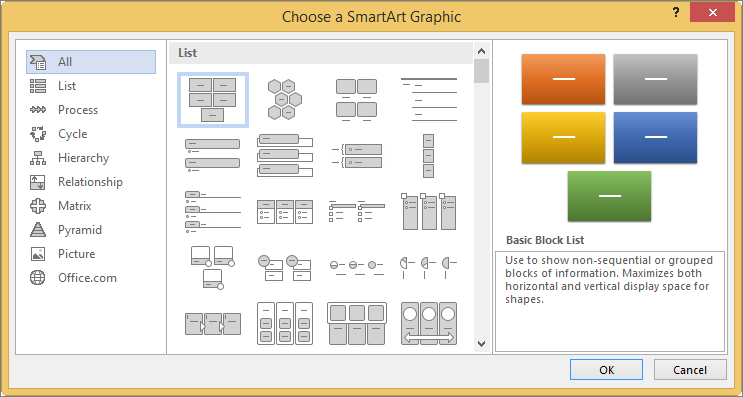
The table below lists examples of a few common uses for SmartArt graphics, and the best SmartArt types to consider for each use.
| To exercise this | Apply this type |
|---|---|
| Prove non-sequential information. | Listing |
| Show steps in a process or timeline. | Procedure |
| Show a continual procedure. | Wheel |
| Create an organization chart. | Hierarchy |
| Show a decision tree. | Hierarchy |
| Illustrate connections. | Relationship |
| Testify how parts relate to a whole. | Matrix |
| Utilise pictures to convey or emphasis content. (Not available in Office 2007) | Motion-picture show |
| Evidence proportional relationships with the largest component on the top or bottom. | Pyramid |
For more guidance on choosing the right SmartArt graphic layout, as well as more information about each layout type, run across Choose a SmartArt graphic.
Almost the Text pane
Apply the Text pane to enter and edit the text that appears in your SmartArt graphic. The Text pane appears to the left of your SmartArt graphic. As yous add and edit your content in the Text pane, your SmartArt graphic is automatically updated — shapes are added or removed as needed.
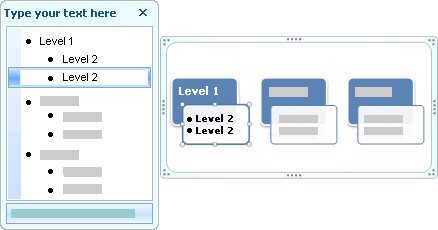
When you lot create a SmartArt graphic, the SmartArt graphic and its Text pane are populated with placeholder text that you lot tin supersede with your information. At the top of the Text pane, you lot tin can edit the text that will announced in your SmartArt graphic. At the bottom of the Text pane, you tin can read a clarification of the SmartArt graphic.
In SmartArt graphics that comprise a fixed number of shapes, only some of the text in the Text pane appears in your SmartArt graphic. Text, pictures, or other content that is not displayed is identified in the Text pane with a red X. This content is notwithstanding available if you switch to another layout, but if y'all proceed and shut this same layout, the information is not saved, to protect your privacy.
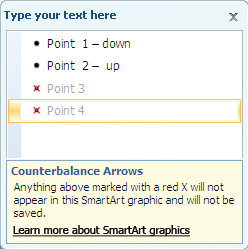
The Text pane works like an outline or a bulleted list that maps information straight to your SmartArt graphic. Each SmartArt graphic defines its ain mapping between the bullets in the Text pane and the set of shapes in the SmartArt graphic.
To create a new line of bulleted text in the Text pane, press Enter. To indent a line in the Text pane, select the line that you desire to indent, and then under SmartArt Tools, on the Pattern tab, click Bench. To negatively indent a line, click Promote. You tin too press Tab to indent or Shift+Tab to negatively indent from inside the Text pane.
If you don't see the SmartArt Tools or Design tabs, double-click the SmartArt graphic.
Depending on the layout that y'all choose, each bullet in the Text pane is represented in the SmartArt graphic equally either a new shape or a bullet inside a shape. For example, detect how the same text is mapped differently in the two SmartArt graphics beneath. In the get-go example, the sub-bullets are represented as separate shapes. In the second case, the sub-bullets are represented as bullets in the shape.

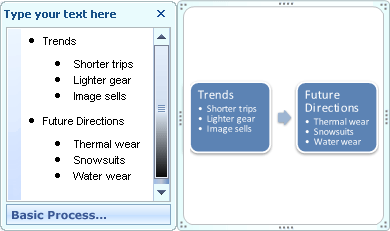
Tip: If you lot practice non want all of your text in dissever shapes, switch to a dissimilar layout that shows all of the text every bit bullets.
If you use an organization chart layout with an Banana shape, a bullet with a line attached indicates the Banana shape.
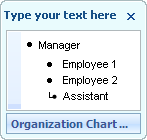
You can utilize character formatting, such equally font, font size, bold, italic, and underline, to the text in your SmartArt graphic by applying the formatting to text in the Text pane, and it is reflected in your SmartArt graphic. When the font size in one shape shrinks considering yous add more text to the shape, all of the other text in the remaining shapes of the SmartArt graphic will also compress to the same size to continue the SmartArt graphic looking consistent and professional.
Afterward you choose a layout, you lot can move your mouse arrow over any of the different layouts displayed on the Pattern tab, and use Live Preview to meet what your content will await similar with that layout applied.
Style, colour, and effects for SmartArt graphics
Under SmartArt Tools, on the Blueprint tab, there are two galleries for quickly changing the look of your SmartArt graphic: SmartArt Styles and Change Colors.
SmartArt Styles include shape fills, edges, shadows, line styles, gradients, and three-dimensional (iii-D) perspectives and are applied to the entire SmartArt graphic. Y'all can also utilize an individual Shape style to one or more shapes in your SmartArt graphic.
The 2d gallery, Alter Colors, provides a range of different colour options for a SmartArt graphic, each one applying one or more theme colors in a unlike way to the shapes in your SmartArt graphic.
When you residual your arrow over a thumbnail in either of these galleries, you tin preview how a SmartArt Way or colour variation affects your SmartArt graphic before yous really apply it.
SmartArt Styles and color combinations are designed to underscore your content. For example, if you utilise a 3-D SmartArt Manner with perspective, y'all can run into anybody on the same level.
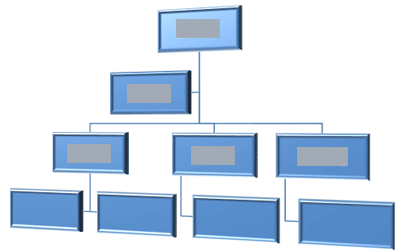
You tin likewise use a 3-D SmartArt Mode with perspective to emphasize a timeline that goes into the future.
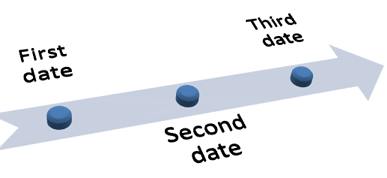
Tip: 3-D SmartArt Styles, especially scene-coherent 3-D, are best used sparingly, to avoid distraction from the message that you want to convey. three-D SmartArt Styles oftentimes work well for the showtime page of a document or the kickoff slide of a presentation.
To emphasize distinct steps in a SmartArt graphic of the Process type, you tin can employ any of the combinations under Colorful.

If you have a SmartArt graphic of the Cycle blazon, you can use whatever of the Accent options to emphasize the circular movement. These colors move along a gradient to the center shape then reverse to the first shape.

When choosing colors, you should also consider whether you desire your audience to print your SmartArt graphic or view information technology online.
Tip: If an image is part of your background slide, color combinations with Transparent in the name work all-time to show off a more refined design in your document.
When you insert a SmartArt graphic into your document without specifying a theme, the graphic theme matches that used by the rest of the content in your document. If you modify the theme of the document, the await of the SmartArt graphic is updated automatically.
Near all parts of a SmartArt graphic are customizable. If the SmartArt Style gallery does not have the combination of fills, lines, and effects you want, you tin use an individual Shape style or fully customize the shape yourself. You lot tin as well move shapes around and resize them. You can observe near of the customization options under SmartArt Tools on the Format tab.
Even after you customize your SmartArt graphic, y'all can change to a dissimilar layout, and nigh of your customizations will be kept. Or to remove all formatting and start over, on the Design tab, in the Reset group, click Reset Graphic.

Blitheness for SmartArt graphics
In PowerPoint, you tin add animation to your SmartArt graphic, or to an individual shape in a SmartArt graphic. For case, y'all can make a shape wing in quickly from i side of your screen or slowly fade in.
The animations that are available depend on the layout that you choose for your SmartArt graphic, but you lot can e'er animate all of the shapes at once or 1 shape at time.
Learn more about blitheness by reading Animate your SmartArt graphic.
See As well
Choose a SmartArt graphic
Create a SmartArt graphic
Animate your SmartArt graphic
Restore the default layout and color of your SmartArt graphic
Source: https://support.microsoft.com/en-us/topic/learn-more-about-smartart-graphics-6ea4fdb0-aa40-4fa9-9348-662d8af6ca2c
0 Response to "How to Merge a Text Box and Smart Art in Word"
Post a Comment